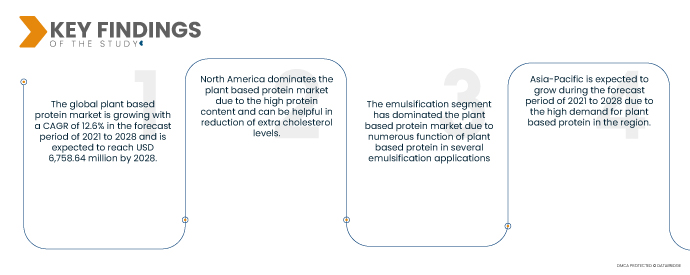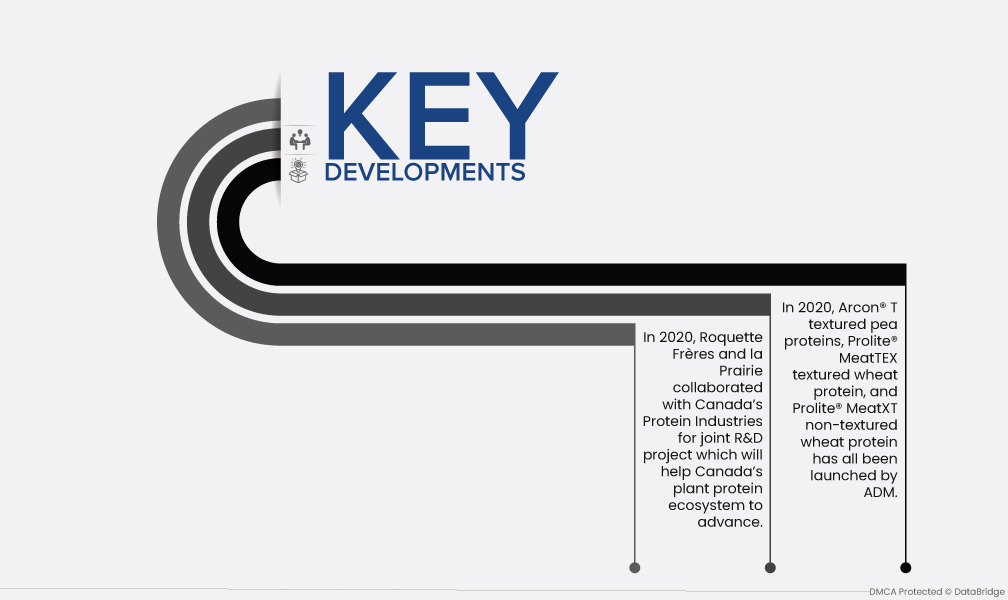Растительные белки имеют огромный спектр применения в пищевой промышленности и производстве напитков. В последние годы рынок растительных белков наблюдал огромный рост в хлебобулочных изделиях, функциональных напитках и других продуктах питания, что делает растительные белки еще более доступными из-за их широкого использования в многочисленных отраслях. Растущий спрос на растительные белки приводит к росту инвестиций и сотрудничества на рынке растительных белков.
Доступ к полному отчету по адресу https://www.databridgemarketresearch.com/reports/global-plant-based-protein-market
По данным Data Bridge Market Research, мировой рынок растительного белка будет расти со среднегодовым темпом роста 12,6% в прогнозируемый период с 2021 по 2028 год и, как ожидается, достигнет 6 758,64 млн долларов США к 2028 году. Растущий спрос на растительный белок предоставит потенциальные возможности для роста рынка в прогнозируемый период.

Ожидается , что рост использования растительного белка в различных областях применения будет способствовать темпам роста рынка.
Растительные белки имеют широкий спектр применения в пищевой промышленности и индустрии напитков. В настоящее время некоторые люди также используют растительные белки в качестве перекуса, поскольку предпочитают здоровые варианты перекусов, такие как протеиновые батончики и чипсы, обогащенные белком. Эти белки также используются в кормах для животных, которые помогают снизить зависимость фермеров от традиционных источников белка в рационе домашней птицы. Например, в 2020 году компания Nestlé запустила протеиновые батончики Yes! в Великобритании и Ирландии в двух вкусах: миндаль, арахис и двойной темный шоколад, а также кешью, черника и темный шоколад, посыпанный орехами и горошком, и каждый батончик содержит 10 г растительного белка.
Область отчета и сегментация рынка
Отчет Метрика
|
Подробности
|
Прогнозируемый период
|
2021-2028
|
Базовый год
|
2020
|
Исторические годы
|
2019 (Можно настроить на 2013 - 2018)
|
Количественные единицы
|
Доход в млн. долл. США, объемы в единицах, цены в долл. США
|
Охваченные сегменты
|
Источник (соевый белок, пшеничный белок, гороховый белок, белок канолы, картофельный белок, рисовый белок, кукурузный белок, овсяный белок, белок льна, конопляный белок, белок киноа, белок чиа и другие), концентрация белка (концентрат, изолят и гидролизат), уровень гидролизации (целый, слабогидролизованный и сильногидролизованный), природа (органический и обычный), форма (сухой и жидкий), функция (растворимость, гелеобразование, эмульгирование, связывание воды, вспенивание и другие), применение (продукты питания и напитки, корма для животных)
|
Страны, охваченные
|
США, Канада, Мексика в Северной Америке, Германия, Швеция, Польша, Дания, Италия, Великобритания, Франция, Испания, Нидерланды, Бельгия, Швейцария, Турция, Россия, Остальная Европа в Европе, Япония, Китай, Индия, Южная Корея, Новая Зеландия, Вьетнам, Австралия, Сингапур, Малайзия, Таиланд, Индонезия, Филиппины, Остальная часть Азиатско-Тихоокеанского региона (APAC) в Азиатско-Тихоокеанском регионе (APAC), Бразилия, Аргентина, Остальная часть Южной Америки как часть Южной Америки, ОАЭ, Саудовская Аравия, Оман, Катар, Кувейт, Южная Африка, Остальной Ближний Восток и Африка (MEA) как часть Ближнего Востока и Африки (MEA)
|
Охваченные участники рынка
|
DSM (Нидерланды), Sotexpro (Франция), Batory Foods (США), Glanbia Plc (Ирландия), AGT Food and Ingredients (Канада), Axiom Foods, Inc (США), Prolupin GmbH (Германия), Yantai Shuangta Food co. LTD (Китай), ADM (США), Wilmar International Ltd (Сингапур), Emsland Group (Германия), Cargill, Incorporated (США), DuPont (США), Ingredion Incorporated (США), Roquette Frères (Франция) и Shandong Jianyuan group (Китай)
|
Данные, отраженные в отчете
|
Помимо информации о рыночных сценариях, таких как рыночная стоимость, темпы роста, сегментация, географический охват и основные игроки, рыночные отчеты, подготовленные Data Bridge Market Research, также включают в себя углубленный экспертный анализ, географически представленные данные о производстве и мощностях компаний, схемы сетей дистрибьюторов и партнеров, подробный и обновленный анализ ценовых тенденций и анализ дефицита цепочки поставок и спроса.
|
Анализ сегмента:
Мировой рынок растительного белка разделен на семь основных сегментов: источник, концентрация белка, уровень гидролизации, форма, природа, функция и применение.
- По источнику рынок растительного белка сегментируется на соевый белок, пшеничный белок, гороховый белок, рапсовый белок, картофельный белок, рисовый белок, кукурузный белок, овсяный белок, белок льняного семени, конопляный белок, белок киноа, белок чиа и другие.
Ожидается, что сегмент исходного соевого белка будет доминировать на рынке растительного белка.
Сегмент соевого белка доминирует на рынке растительного белка с долей рынка 38,46% из-за более высокого содержания белка в сое по сравнению с другими. Поэтому соевые белки в основном используются в качестве источников белка в многочисленных отраслях пищевой промышленности.
- По концентрации белка рынок растительного белка сегментируется на концентрат, изолят и гидролизат.
Ожидается, что сегмент концентратов белков будет доминировать на рынке белков растительного происхождения.
Сегмент концентратов доминирует на рынке растительного белка с долей рынка 48,43%, поскольку изолят считается самой чистой формой белка с более высоким содержанием белка.
- На основе уровня гидролизации рынок растительного белка сегментируется на цельный, слабогидролизованный, сильногидролизованный. Сегмент слабогидролизованного белка доминирует на рынке растительного белка с долей рынка 60,29% из-за его огромного применения и использования в пищевой промышленности и производстве напитков.
- На основе природы рынок растительного белка сегментируется на органический и обычный. Сегмент доминирует на рынке растительного белка с долей рынка 84,24%, поскольку его легко переносить и транспортировать, а также он имеет более длительный срок хранения
- На основе формы рынок растительного белка сегментируется на сухой и жидкий. Сухой сегмент доминирует на рынке растительного белка с долей рынка 84,22% из-за легкой доступности сырья для обычных продуктов
- На основе функции рынок растительного белка сегментируется на растворимость, гелеобразование, эмульгирование, связывание воды, вспенивание и др. Сегмент эмульгирования доминирует на рынке растительного белка с долей рынка 33,87 % из-за многочисленных функций растительного белка в нескольких приложениях эмульгирования.
- На основе приложений рынок растительного белка сегментируется на продукты питания и напитки И корма для животных. Сегмент продуктов питания и напитков доминирует на рынке растительного белка с долей рынка 74,20% из-за увеличения использования растительных белков в продуктах питания и напитках в качестве заменителей мяса.
Основные игроки
Компания Data Bridge Market Research признает следующие компании основными игроками на рынке растительного белка: DSM (Нидерланды), Sotexpro (Франция), Batory Foods (США), Glanbia Plc (Ирландия), AGT Food and Ingredients (Канада), Axiom Foods, Inc (США), Prolupin GmbH (Германия), Yantai Shuangta Food co. LTD (Китай), ADM (США), Wilmar International Ltd (Сингапур), Emsland Group (Германия), Cargill, Incorporated (США), DuPont (США), Ingredion Incorporated (США), Roquette Frères (Франция) и Shandong Jianyuan group (Китай).
Развитие рынка

- В 2020 году Roquette Frères и la Prairie сотрудничали с канадской Protein Industries для совместного проекта НИОКР, который поможет канадской экосистеме растительного белка продвинуться вперед. Это поможет компании возглавить и расширить свои НИОКР, развитие навыков и возможности для цепочки создания стоимости за счет повышения технической совместимости совместных исследовательских организаций.
- В 2020 году компания ADM выпустила на рынок текстурированные гороховые белки Arcon T, текстурированный пшеничный белок Prolite® MeatTEX и нетекстурированный пшеничный белок Prolite® MeatXT. Эти высокофункциональные белковые решения улучшают текстуру и плотность заменителей мяса и особенно полезны для достижения предпочитаемой потребителями текстуры, похожей на мясо.
Региональный анализ
Географически в отчете о рынке растительного белка рассматриваются следующие страны: США, Канада, Мексика в Северной Америке, Германия, Швеция, Польша, Дания, Италия, Великобритания, Франция, Испания, Нидерланды, Бельгия, Швейцария, Турция, Россия, остальные страны Европы в Европе, Япония, Китай, Индия, Южная Корея, Новая Зеландия, Вьетнам, Австралия, Сингапур, Малайзия, Таиланд, Индонезия, Филиппины, остальные страны Азиатско-Тихоокеанского региона (APAC) в Азиатско-Тихоокеанском регионе (APAC), Бразилия, Аргентина, остальные страны Южной Америки как часть Южной Америки, ОАЭ, Саудовская Аравия, Оман, Катар, Кувейт, Южная Африка, остальные страны Ближнего Востока и Африки (MEA) как часть Ближнего Востока и Африки (MEA).
Согласно анализу Data Bridge Market Research:
Северная Америка будет доминирующим регионом на рынке растительного белка в прогнозируемый период с 2021 по 2028 год.
Северная Америка доминирует на рынке растительного белка из-за высокого спроса на органические и питательные продукты питания. Кроме того, высокий спрос на органические и питательные продукты питания в этом регионе стимулирует рост рынка.
По оценкам, Азиатско-Тихоокеанский регион станет самым быстрорастущим регионом на рынке растительного белка в прогнозируемый период с 2021 по 2028 год.
Ожидается, что Азиатско-Тихоокеанский регион будет расти в прогнозируемый период с 2021 по 2028 год из-за растущего спроса на растительный белок в регионе из-за факторов, которые способствуют снижению веса и помогают снизить сердечно-сосудистые заболевания. Кроме того, ожидается, что увеличение располагаемого дохода повысит темпы роста рынка в этом регионе.
Для получения более подробной информации об отчете о рынке растительного белка нажмите здесь – https://www.databridgemarketresearch.com/reports/global-plant-based-protein-market










